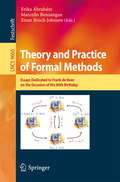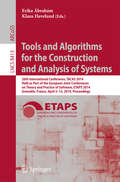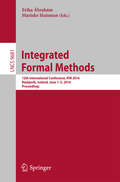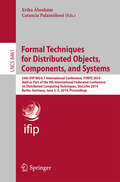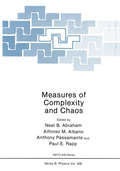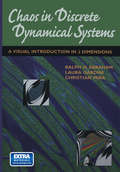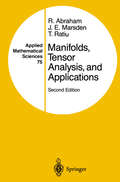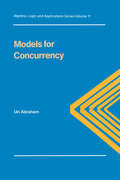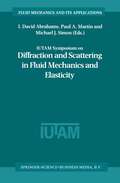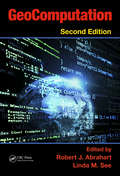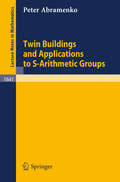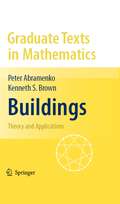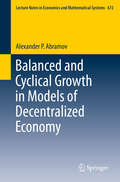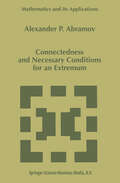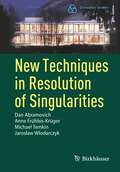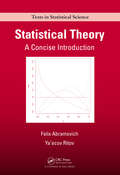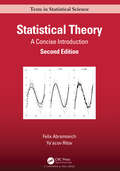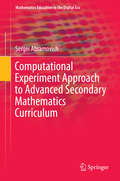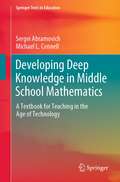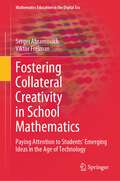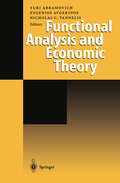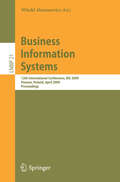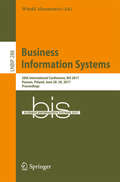- Table View
- List View
Theory and Practice of Formal Methods: Essays Dedicated to Frank de Boer on the Occasion of His 60th Birthday (Lecture Notes in Computer Science #9660)
by Erika Ábrahám Marcello Bonsangue Einar Broch JohnsenThis Festschrift volume has been published in honor of Frank de Boer, on the occasion of his 60th birthday. Frank S. de Boer is a prominent member of the research community in formal methods and theoretical computer science. A brief look at his lengthy publication list reveals a broad area of interest and a versatile modus operandi with: logic and constraint programming; deductive proof systems, soundness, and completeness; semantics, compositionality, and full abstraction; process algebra and decidability; multithreading and actor-based concurrency; agent programming, ontologies, and modal logic; real-time systems, timed automata, and schedulability; enterprise architectures, choreography, and coordination; testing and runtime monitoring; and cloud computing and service-level agreements. For a while, he also liked failures, especially in semantics, and optimistically concluded with the failure of failures. In fact, Frank has an opportunistic approach to research. Rather than seeing obstacles, he finds opportunities.
Tools and Algorithms for the Construction and Analysis of Systems: 20th International Conference, TACAS 2014, Held as Part of the European Joint Conferences on Theory and Practice of Software, ETAPS 2014, Grenoble, France, April 5-13, 2014, Proceedings (Lecture Notes in Computer Science #8413)
by Erika Ábrahám Klaus HavelundThis book constitutes the proceedings of the 20th International Conference on Tools and Algorithms for the Construction and Analysis of Systems, TACAS 2014, which took place in Grenoble, France, in April 2014, as part of the European Joint Conferences on Theory and Practice of Software, ETAPS 2014. The total of 42 papers included in this volume, consisting of 26 research papers, 3 case study papers, 6 regular tool papers and 7 tool demonstrations papers, were carefully reviewed and selected from 161 submissions. In addition the book contains one invited contribution. The papers are organized in topical sections named: decision procedures and their application in analysis; complexity and termination analysis; modeling and model checking discrete systems; timed and hybrid systems; monitoring, fault detection and identification; competition on software verification; specifying and checking linear time properties; synthesis and learning; quantum and probabilistic systems; as well as tool demonstrations and case studies.
Integrated Formal Methods: 12th International Conference, IFM 2016, Reykjavik, Iceland, June 1-5, 2016, Proceedings (Lecture Notes in Computer Science #9681)
by Erika Ábrahám Marieke HuismanThis book constitutes the refereed proceedings of the 12th International Conference on Integrated Formal Methods, IFM 2016, held in Reykjavik, Iceland, in June 2016.The 33 papers presented in this volume were carefully reviewed and selected from 99 submissions. They were organized in topical sections named: invited contributions; program verification; probabilistic systems; concurrency; safety and liveness; model learning; SAT and SMT solving; testing; theorem proving and constraint satisfaction; case studies.
Formal Techniques for Distributed Objects, Components, and Systems: 34th IFIP WG 6.1 International Conference, FORTE 2014, Held as Part of the 9th International Federated Conference on Distributed Computing Techniques, DisCoTec 2014, Berlin, Germany, June 3-5, 2014, Proceedings (Lecture Notes in Computer Science #8461)
by Erika Ábrahám Catuscia PalamidessiThis book constitutes the proceedings of the 34th IFIP WG 6.1 International Conference on Formal Techniques for Distributed Objects, Components and Systems, FORTE 2014, held in Berlin, Germany, in June 2014, as part of the 9th International Federated Conference on Distributed Computing Techniques, DisCoTec 2014. The 18 revised full papers presented were carefully reviewed and selected from 50 submissions. The papers present a wide range of topics on specification languages and type systems, monitoring and testing, security analysis and bisimulation, abstraction and reduction.
Measures of Complexity and Chaos (Nato Science Series B: #208)
by Neal B. Abraham Alfonso M. Albano Anthony Passamante Paul RappThis volume serves as a general introduction to the state of the art of quantitatively characterizing chaotic and turbulent behavior. It is the outgrowth of an international workshop on "Quantitative Measures of Dynamical Complexity and Chaos" held at Bryn Mawr College, June 22-24, 1989. The workshop was co-sponsored by the Naval Air Development Center in Warminster, PA and by the NATO Scientific Affairs Programme through its special program on Chaos and Complexity. Meetings on this subject have occurred regularly since the NATO workshop held in June 1983 at Haverford College only two kilometers distant from the site of this latest in the series. At that first meeting, organized by J. Gollub and H. Swinney, quantitative tests for nonlinear dynamics and chaotic behavior were debated and promoted [1). In the six years since, the methods for dimension, entropy and Lyapunov exponent calculations have been applied in many disciplines and the procedures have been refined. Since then it has been necessary to demonstrate quantitatively that a signal is chaotic rather than it being acceptable to observe that "it looks chaotic". Other related meetings have included the Pecos River Ranch meeting in September 1985 of G. Mayer Kress [2) and the reflective and forward looking gathering near Jerusalem organized by M. Shapiro and I. Procaccia in December 1986 [3). This meeting was proof that interest in measuring chaotic and turbulent signals is widespread.
Chaos in Discrete Dynamical Systems: A Visual Introduction in 2 Dimensions
by Ralph Abraham Laura Gardini Christian MiraThe materials in the book and on the accompanying disc are not solely developed with only the researcher and professional in mind, but also with consideration for the student: most of this material has been class-tested by the authors. The book is packed with some 100 computer graphics to illustrate the material, and the CD-ROM contains full-colour animations tied directly to the subject matter of the book itself. The cross-platform CD also contains the program ENDO, which enables users to create their own 2-D imagery with X-Windows. Maple scripts are provided to allow readers to work directly with the code from which the graphics in the book were taken.
Manifolds, Tensor Analysis, and Applications (Applied Mathematical Sciences #75)
by Ralph Abraham Jerrold E. Marsden Tudor RatiuThe purpose of this book is to provide core material in nonlinear analysis for mathematicians, physicists, engineers, and mathematical biologists. The main goal is to provide a working knowledge of manifolds, dynamical systems, tensors, and differential forms. Some applications to Hamiltonian mechanics, fluid me chanics, electromagnetism, plasma dynamics and control thcory arc given in Chapter 8, using both invariant and index notation. The current edition of the book does not deal with Riemannian geometry in much detail, and it does not treat Lie groups, principal bundles, or Morse theory. Some of this is planned for a subsequent edition. Meanwhile, the authors will make available to interested readers supplementary chapters on Lie Groups and Differential Topology and invite comments on the book's contents and development. Throughout the text supplementary topics are given, marked with the symbols ~ and {l:;J. This device enables the reader to skip various topics without disturbing the main flow of the text. Some of these provide additional background material intended for completeness, to minimize the necessity of consulting too many outside references. We treat finite and infinite-dimensional manifolds simultaneously. This is partly for efficiency of exposition. Without advanced applications, using manifolds of mappings, the study of infinite-dimensional manifolds can be hard to motivate.
Models for Concurrency
by Uri AbrahamConcurrent systems are generally understood in terms of behavioral notions. Models for Concurrency analyzes the subject in terms of events and their temporal relationship rather than on global states. It presents a comprehensive analysis of model theory applied to concurrent protocols, and seeks to provide a theory of concurrency that is both intuitively appealing and rigorously based on mathematical foundations. The book is divided into three main sections. The first introduces the required concepts from model theory, details the structures that are used to model concurrency, gives an in-depth description and explanation of the semantics of a simple language that allows concurrent execution of sequential programs, and deals with the question of resolving executions into higher-level and lower-level granularities. The second and third sections apply the theory developed to practical examples, and an exposition of the producer/consumer problem with details of two solutions is given. The author also deals with message passing, as opposed to shared memory.
Models for Concurrency
by Uri AbrahamConcurrent systems are generally understood in terms of behavioral notions. Models for Concurrency analyzes the subject in terms of events and their temporal relationship rather than on global states. It presents a comprehensive analysis of model theory applied to concurrent protocols, and seeks to provide a theory of concurrency that is both intuitively appealing and rigorously based on mathematical foundations. The book is divided into three main sections. The first introduces the required concepts from model theory, details the structures that are used to model concurrency, gives an in-depth description and explanation of the semantics of a simple language that allows concurrent execution of sequential programs, and deals with the question of resolving executions into higher-level and lower-level granularities. The second and third sections apply the theory developed to practical examples, and an exposition of the producer/consumer problem with details of two solutions is given. The author also deals with message passing, as opposed to shared memory.
IUTAM Symposium on Diffraction and Scattering in Fluid Mechanics and Elasticity: Proceeding of the IUTAM Symposium held in Manchester, United Kingdom, 16–20 July 2000 (Fluid Mechanics and Its Applications #68)
by I. David Abrahams Paul A. Martin Michael J. SimonThese Conference Proceedings are intended to summarise the latest developments in diffraction and scattering theory as reported at the IU TAM Symposium on Diffraction and Scattering in Fluid Mechanics and Elasticity held in Manchester, England on 16-20 July 2000. This in formal meeting was organised to discuss mathematical advances, both from the theoretical and more applied points of view. However, its pri mary goal was to bring together groups of researchers working in dis parate application areas, but who nevertheless share common models, phenomenological features arising in such problems, and common math ematical tools. To this end, we were delighted to have four Plenary Speakers, Professors Allan Pierce, Ed Kerschen, Roger Grimshaw and John Willis FRS, who are undisputed leaders in the four thematic ar eas of our meeting (these are respectively acoustics, aeroacoustics, water or other free surface waves, elasticity). These Proceedings should offer an excellent vehicle for continuing the dialogue between these groups of researchers. The participants were invited because of their expertise and recent contributions to this field. Collectively, there were around 90 contrib utors to the Symposium from some 13 countries located all around the world. These included 45 speakers, 35 co-authors and about 10 other delegates. Individuals came from many of the major international cen tres of excellence in the field of scattering theory.
GeoComputation
by Robert J. Abrahart Linda M. SeeA revision of Openshaw and Abrahart's seminal work, GeoComputation, Second Edition retains influences of its originators while also providing updated, state-of-the-art information on changes in the computational environment. In keeping with the field's development, this new edition takes a broader view and provides comprehensive coverage across the
Twin Buildings and Applications to S-Arithmetic Groups (Lecture Notes in Mathematics #1641)
by Peter AbramenkoThis book is addressed to mathematicians and advanced students interested in buildings, groups and their interplay. Its first part introduces - presupposing good knowledge of ordinary buildings - the theory of twin buildings, discusses its group-theoretic background (twin BN-pairs), investigates geometric aspects of twin buildings and applies them to determine finiteness properties of certain S-arithmetic groups. This application depends on topological properties of some subcomplexes of spherical buildings. The background of this problem, some examples and the complete solution for all "sufficiently large" classical buildings are covered in detail in the second part of the book.
Buildings: Theory and Applications (Graduate Texts in Mathematics #248)
by Peter Abramenko Kenneth S. BrownThis book treats Jacques Tit's beautiful theory of buildings, making that theory accessible to readers with minimal background. It covers all three approaches to buildings, so that the reader can choose to concentrate on one particular approach. Beginners can use parts of the new book as a friendly introduction to buildings, but the book also contains valuable material for the active researcher. This book is suitable as a textbook, with many exercises, and it may also be used for self-study.
Balanced and Cyclical Growth in Models of Decentralized Economy (Lecture Notes in Economics and Mathematical Systems #672)
by Alexander P. AbramovThis book is devoted to the study of dynamical models of decentralized economic systems. The models considered are based on the Leontief simple dynamic model with various mechanisms for decentralized planning and management. Branches of the economic system are treated as fully independent economic agents that plan their work according to their own purposes. It is shown that the lack of coordination between economic agents leads to a limit cycle for some economic indicators. Conversely, the exchange of information between the economic agents enables a move toward balanced growth. These results are generalized for the model with dynamics of the productive assets and for the model with the final consumption. The analysis also considers a problem of endogenous technological progress in a decentralized economy. The appendix includes a short review of non-negative matrices. The book offers a valuable resource for mathematical economists and graduate students specializing in mathematical economics.
Connectedness and Necessary Conditions for an Extremum (Mathematics and Its Applications #431)
by Alexey AbramovThe present book is the outcome of efforts to introduce topological connectedness as one of the basic tools for the study of necessary conditions for an extremum. Apparently this monograph is the first book in the theory of maxima and minima where topological connectedness is used so widely for this purpose. Its application permits us to obtain new results in this sphere and to consider the classical results from a nonstandard point of view. Regarding the style of the present book it should be remarked that it is comparatively elementary. The author has made constant efforts to make the book as self-contained as possible. Certainly, familiarity with the basic facts of topology, functional analysis, and the theory of optimization is assumed. The book is written for applied mathematicians and graduate students interested in the theory of optimization and its applications. We present the synthesis of the well known Dybovitskii'-Milyutin ap proach for the study of necessary conditions for an extremum, based on functional analysis, and topological methods. This synthesis allows us to show that in some cases we have the following important result: if the Euler equation has no non trivial solution at a point of an extremum, then some inclusion is valid for the functionals belonging to the dual space. This general result is obtained for an optimization problem considered in a lin ear topological space. We also show an application of our result to some problems of nonlinear programming and optimal control.
New Techniques in Resolution of Singularities (Oberwolfach Seminars #50)
by Dan Abramovich Anne Frühbis-Krüger Michael Temkin Jarosław WłodarczykResolution of singularities is notorious as a difficult topic within algebraic geometry. Recent work, aiming at resolution of families and semistable reduction, infused the subject with logarithmic geometry and algebraic stacks, two techniques essential for the current theory of moduli spaces. As a byproduct a short, a simple and efficient functorial resolution procedure in characteristic 0 using just algebraic stacks was produced. The goals of the book, the result of an Oberwolfach Seminar, are to introduce readers to explicit techniques of resolution of singularities with access to computer implementations, introduce readers to the theories of algebraic stacks and logarithmic structures, and to resolution in families and semistable reduction methods.
Statistical Theory: A Concise Introduction (Chapman And Hall/crc Texts In Statistical Science Ser.)
by Felix AbramovichDesigned for a one-semester advanced undergraduate or graduate course, Statistical Theory: A Concise Introduction clearly explains the underlying ideas and principles of major statistical concepts, including parameter estimation, confidence intervals, hypothesis testing, asymptotic analysis, Bayesian inference, and elements of decision theory. It i
Statistical Theory: A Concise Introduction (Chapman & Hall/CRC Texts in Statistical Science)
by Felix Abramovich Ya'acov RitovDesigned for a one-semester advanced undergraduate or graduate statistical theory course, Statistical Theory: A Concise Introduction, Second Edition clearly explains the underlying ideas, mathematics, and principles of major statistical concepts, including parameter estimation, confidence intervals, hypothesis testing, asymptotic analysis, Bayesian inference, linear models, nonparametric statistics, and elements of decision theory. It introduces these topics on a clear intuitive level using illustrative examples in addition to the formal definitions, theorems, and proofs. Based on the authors’ lecture notes, the book is self-contained, which maintains a proper balance between the clarity and rigor of exposition. In a few cases, the authors present a "sketched" version of a proof, explaining its main ideas rather than giving detailed technical mathematical and probabilistic arguments. Features: Second edition has been updated with a new chapter on Nonparametric Estimation; a significant update to the chapter on Statistical Decision Theory; and other updates throughout No requirement for heavy calculus, and simple questions throughout the text help students check their understanding of the material Each chapter also includes a set of exercises that range in level of difficulty Self-contained, and can be used by the students to understand the theory Chapters and sections marked by asterisks contain more advanced topics and may be omitted Special chapters on linear models and nonparametric statistics show how the main theoretical concepts can be applied to well-known and frequently used statistical tools The primary audience for the book is students who want to understand the theoretical basis of mathematical statistics—either advanced undergraduate or graduate students. It will also be an excellent reference for researchers from statistics and other quantitative disciplines.
Statistical Theory: A Concise Introduction (Chapman & Hall/CRC Texts in Statistical Science)
by Felix Abramovich Ya'acov RitovDesigned for a one-semester advanced undergraduate or graduate statistical theory course, Statistical Theory: A Concise Introduction, Second Edition clearly explains the underlying ideas, mathematics, and principles of major statistical concepts, including parameter estimation, confidence intervals, hypothesis testing, asymptotic analysis, Bayesian inference, linear models, nonparametric statistics, and elements of decision theory. It introduces these topics on a clear intuitive level using illustrative examples in addition to the formal definitions, theorems, and proofs. Based on the authors’ lecture notes, the book is self-contained, which maintains a proper balance between the clarity and rigor of exposition. In a few cases, the authors present a "sketched" version of a proof, explaining its main ideas rather than giving detailed technical mathematical and probabilistic arguments. Features: Second edition has been updated with a new chapter on Nonparametric Estimation; a significant update to the chapter on Statistical Decision Theory; and other updates throughout No requirement for heavy calculus, and simple questions throughout the text help students check their understanding of the material Each chapter also includes a set of exercises that range in level of difficulty Self-contained, and can be used by the students to understand the theory Chapters and sections marked by asterisks contain more advanced topics and may be omitted Special chapters on linear models and nonparametric statistics show how the main theoretical concepts can be applied to well-known and frequently used statistical tools The primary audience for the book is students who want to understand the theoretical basis of mathematical statistics—either advanced undergraduate or graduate students. It will also be an excellent reference for researchers from statistics and other quantitative disciplines.
Computational Experiment Approach to Advanced Secondary Mathematics Curriculum (Mathematics Education in the Digital Era #3)
by Sergei AbramovichThis book promotes the experimental mathematics approach in the context of secondary mathematics curriculum by exploring mathematical models depending on parameters that were typically considered advanced in the pre-digital education era. This approach, by drawing on the power of computers to perform numerical computations and graphical constructions, stimulates formal learning of mathematics through making sense of a computational experiment. It allows one (in the spirit of Freudenthal) to bridge serious mathematical content and contemporary teaching practice. In other words, the notion of teaching experiment can be extended to include a true mathematical experiment. When used appropriately, the approach creates conditions for collateral learning (in the spirit of Dewey) to occur including the development of skills important for engineering applications of mathematics. In the context of a mathematics teacher education program, the book addresses a call for the preparation of teachers capable of utilizing modern technology tools for the modeling-based teaching of mathematics with a focus on methods conducive to the improvement of the whole STEM education at the secondary level. By the same token, using the book’s pedagogy and its mathematical content in a pre-college classroom can assist teachers in introducing students to the ideas that develop the foundation of engineering profession.
Developing Deep Knowledge in Middle School Mathematics: A Textbook for Teaching in the Age of Technology (Springer Texts in Education)
by Sergei Abramovich Michael L. ConnellThis textbook is for prospective teachers of middle school mathematics. It reflects on the authors’ experience in offering various mathematics education courses to prospective teachers in the US and Canada. In particular, the content can support one or more of 24-semester-hour courses recommended by the Conference Board of the Mathematical Sciences (2012) for the mathematical preparation of middle school teachers. The textbook integrates grade-appropriate content on all major topics in the middle school mathematics curriculum with international recommendations for teaching the content, making it relevant for a global readership. The textbook emphasizes the inherent connections between mathematics and real life, since many mathematical concepts and procedures stem from common sense, something that schoolchildren intuitively possess. This focus on teaching formal mathematics with reference to real life and common sense is essential to its pedagogical approach. In addition, the textbook stresses the importance of being able to use technology as an exploratory tool, and being familiar with its strengths and weaknesses. In keeping with this emphasis on the use of technology, both physical (manipulatives) and digital (commonly available educational software), it also explores e.g. the use of computer graphing software for digital fabrication. In closing, the textbook addresses the issue of creativity as a crucial aspect of education in the digital age in general, and in mathematics education in particular.
Fostering Collateral Creativity in School Mathematics: Paying Attention to Students’ Emerging Ideas in the Age of Technology (Mathematics Education in the Digital Era #23)
by Sergei Abramovich Viktor FreimanThis book explores the topic of using technology, both physical and digital, to motivate creative mathematical thinking among students who are not considered ‘mathematically advanced.’ The book reflects the authors’ experience of teaching mathematics to Canadian and American teacher candidates and supervising several field-based activities by the candidates. It consists of eight chapters and an Appendix which includes details of constructing computational learning environments.Specifically, the book demonstrates how the appropriate use of technology in the teaching of mathematics can create conditions for the emergence of what may be called ‘collateral creativity,’ a notion similar to Dewey’s notion of collateral learning. Just as collateral learning does not result from the immediate goal of the traditional curriculum, collateral creativity does not result from the immediate goal of traditional problem solving. Rather, mathematical creativity emerges as a collateral outcome of thinking afforded by the use of technology. Furthermore, collateral creativity is an educative outcome of one’s learning experience with pedagogy that motivates students to ask questions about computer-generated or tactile-derived information and assists them in finding answers to their own or the teacher’s questions. This book intends to provide guidance to teachers for fostering collateral creativity in their classrooms.
Functional Analysis and Economic Theory
by Yuri Abramovich Evgenios Avgerinos Nicholas C. YannelisIn July of 1996, the conference Nonlinear Analysis and its Applications in Engineering and Economics took place on the Greek island of Samos, the birthplace of Pythagoras. During this conference, a special session was held on th the occasion of the 50 birthday of the well known mathematician and math ematical economist Professor Charalambos Aliprantis, who, by his numerous friends, is usually called Roko. The story behind this nickname is not quite clear yet; it will be investigated further and will be made public prior to his th 60 birthday. (At this moment we have already found out that it has nothing to do with the famous movie Rocco and his Brothers even though Roko does have two brothers. ) Roko was born on the Greek island of Cephalonia on May 12,1946, and his elementary and secondary school education took place there. At 18 he entered the Mathematics Department at the University of Athens. Upon graduation from the University of Athens he proceeded with his graduate studies at Cal tech, where in 1973 he completed his Ph. D. degree in Mathematics under the supervision of Professor W. A. J. Luxemburg. His research career can be divided into two periods. The first one, till 1981, was devoted entirely to pure mathematics. The other one, after 1981, has been subdivided between pure mathematics and mathematical economics. The main objects of Roko's work in pure mathematics are spaces with order structure (Riesz spaces) and operators acting on them.
Business Information Systems: 12th International Conference, BIS 2009, Poznan, Poland, April 27-29, 2009, Proceedings (Lecture Notes in Business Information Processing #21)
by Witold AbramowiczBusiness Information Systems: 20th International Conference, BIS 2017, Poznan, Poland, June 28–30, 2017, Proceedings (Lecture Notes in Business Information Processing #288)
by Witold AbramowiczThis book constitutes the refereed proceedings of the 20th International Conference on Business Information Systems, BIS 2017, held in Poznań, Poland, in June 2017. Big Data Analytics helps to understand and enhance enterprises by linking many fields of information technology and business. This year’s conference theme was: Big Data Analytics for Business and Public Administration. The 24 full papers presented in this volume were carefully reviewed and selected from 72 submissions. They were organized in topical sections named: big and smart data; business and enterprise modeling; ICT project management; process management; smart infrastructure; and applications.
